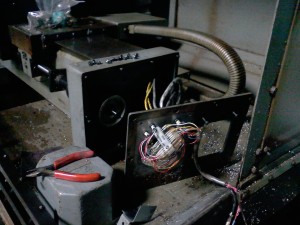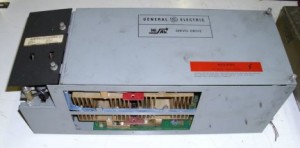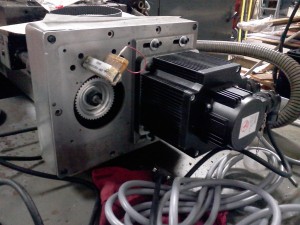6/28/2013 – We are thinking about using the larger motor, and direct coupling it to the screw. The motor is 4 n*m, or about 35 in-lb continuous. The output shaft is 22mm, which is slightly larger than the screw. The end of the screw is 15mm, with a 1/8″ key. Strange, but true. We can get a coupling and make a standoff to mount the motor.
The Z axis is driven by a 3/4 diameter 0.2″ pitch ballscrew. The nut is run in an oilbath, and the screw is protected by a very sturdy telescoping cover.
 At a glance, the Z axis looks good. The way wipers will have to be replaced, because they have completely rotted to a point of uselessness. The basic mechanics looks good.
At a glance, the Z axis looks good. The way wipers will have to be replaced, because they have completely rotted to a point of uselessness. The basic mechanics looks good.
The screw appears to be driven through a gear pass, but I don’t have the cover off yet.
The feedback system consists of a resolver and tachometer driven off the screw. It is interesting that they chose to get the velocity feedback directly off the screw, instead of the motor. At any rate, all of this stuff will go. We will do a belt pass from the motor to the screw, and use the motor resolver for all of our feedback requirements.
I don’t know yet what the thrust bearing arrangement is. Hopefully it is not an oil bath, because that might make it difficult to do a simple belt pass. We may need to design in a seal for the oil bath if that is what is there. It very likely will be.
Well, as it turns out, there was already a 4:1 belt pass (48t on the screw, to 12t on the motor), and no exposed oil bath. If there is an oil bath on the screw thrust bearings, it is not exposed. We will probably be able to use the existing pulley arrangement. We may have to get a new pulley for the motor. We may want to upgrade the whole arrangement by getting a more modern belt tooth form.
By turning the screw pulley by hand, it is clear that the slide construction has more friction than roller way systems. The slide is a ground steel dovetail. It is not possible to tell right off what the liner material is. I would guess that there is some kind of teflon based liner material, but it may be iron on steel. We could possibly pull a gib and see what we can see. If we pull off the way wipers it might become clear too. This type of construction will provide great finishes on the cuts, probably, but maybe a little trouble around corners and direction reversals.
A picture of a GE Hi-Ak drive simiar to the drives in this machine:
This is the business end of the Z axis with the new motor mounted. The belt is not yet in place, because we want to get the motor running prior to having the belt connected, in case we have any trouble getting control of it.
The pulleys were both replaced. The motor shaft is too large to take the original pulley, and we wanted to move up to a more modern tooth form.
2014-03-21


